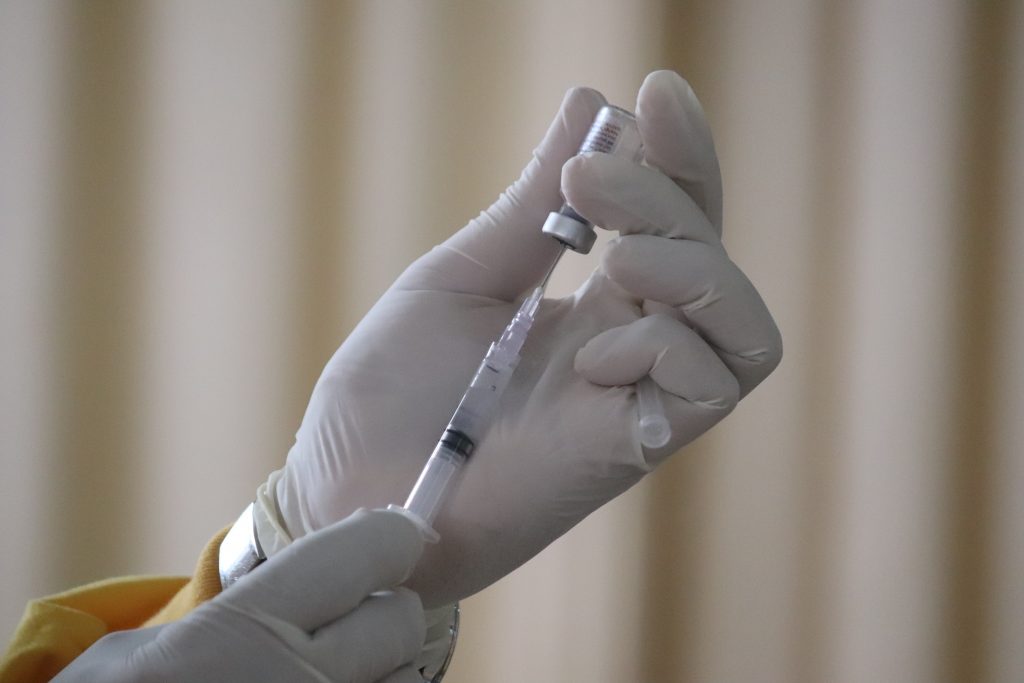- OSHA releases emergency temporary standard on workplace COVID-19 vaccination policies, applicable to companies with 100 or more employees
- Unvaccinated employees must start wearing face coverings when working with others and begin weekly testing for COVID-19 starting Jan. 4
- Rule exempts certain workers, establishes paid leave for employees to get vaccinated
Summary by Dirk Langeveld
The Occupational Health and Safety Administration has released its emergency temporary standard on workplace COVID-19 vaccination policies. The rule applies to businesses with 100 or more employees, affecting approximately 84 million workers – about two-thirds of the private sector workforce.
Under the rule, eligible employers must develop, implement, and enforce a mandatory COVID-19 vaccination policy. Alternatively, they can adopt a policy requiring employees to choose whether to get vaccinated or to submit to weekly testing and wearing a face covering when working alongside others.
While the mandate has received some pushback from critics who say the agency is overstepping its authority, OSHA says the emergency temporary standard is a necessary step to protect workers. It says many people who have been hospitalized or died due to COVID-19 suffered exposure to the virus in the workplace, and that the virus presents a “grave danger” to unvaccinated workers.
OSHA is currently evaluating whether the requirements in the emergency temporary standard can feasibly be implemented at smaller employers. For medium-sized and larger companies subject to the rule, these are some of the key provisions established by the mandate.
Important dates
The standard became effective after its publication in the Federal Register today. Employers must comply with most provisions within 30 days and with COVID-19 testing requirements within 60 days.
The effective date for the bulk of the provisions is Dec. 5. Starting on Jan. 4, employees at businesses subject to the rule must be fully vaccinated or subject to weekly COVID-19 testing.
Exempted employees
In addition to fully vaccinated employees, the provisions of the emergency temporary standard do not apply to certain workers. These include employees who are fully remote, any other workers that do not report to workplaces where others are physically present, and employees who exclusively perform their work duties outdoors.
Unvaccinated workers who were previously infected with COVID-19 are not exempt from rules applicable to unvaccinated workers.
Employees can seek a medical or religious exemption from the vaccine requirement. However, they must abide by other requirements outlined in the rule as an alternative to getting the vaccine.
Testing requirements
Beginning on Jan. 4, unvaccinated employees must test weekly for COVID-19 if they are in the workplace at least once a week. They must also test negative for COVID-19 within seven days of returning to work if they are away from the workplace for one week or longer.
Employers are not required to pay for the testing, except in cases where other laws and regulations or collective bargaining agreements require them to do so. Otherwise, employees are required to absorb any costs involved in the weekly testing.
If an employee tests positive for COVID-19 or is diagnosed with the virus, they must promptly inform their employer. The employer must then remove them from the workplace, regardless of their vaccination status. The employee must not be allowed to return until they test negative for COVID-19, meet the criteria in the Centers for Disease Control’s Isolation Guidance, or receive a recommendation to return to work from a licensed health care provider.
Face coverings
Starting on Dec. 5, unvaccinated employees must begin wearing a face covering when in workplace settings or company vehicles with other people. As with the testing requirement, employers are not required to cover any costs of purchasing these coverings unless a separate law, regulation, or collective bargaining agreement demands it.
Face coverings are not required in certain circumstances. These include when the employee is alone in an enclosed room with closed door; when they are wearing a respirator or face mask; for limited periods when eating or drinking, or for identification purposes; or when the employer can demonstrate that use of face coverings will result in a greater hazard.
Paid time off
The standard suggests that some employees have avoided getting a COVID-19 vaccine due to concerns about missing work or being docked pay. It addresses this issue by directing employers to provide “reasonable time” to employees to get the vaccine and recover from any side effects.
Reasonable time includes up to four hours of paid leave at the employee’s regular rate of pay as well as paid sick leave during their recovery from side effects. It can cover all time necessary to complete a vaccination appointment, including travel to a clinic, registering and completing paperwork, receiving a dose, and post-vaccination monitoring by the vaccine provider.
Employers are not required to provide paid time off for the removal of an employee from the workplace due to a positive COVID-19 test or a COVID-19 diagnosis. They are also not required to provide paid time off if an employee receives a vaccine or recovers from side effects during non-work hours.
The rule states that employers may sometimes have an arrangement where employees does not require as much time to get a dose, such as when a workplace sets up an on-site vaccine clinic. It states that in these circumstances, extra time off may be unpaid but should also be considered protected leave.
Record keeping
Employers must keep a roster of the vaccination status of each employee by determining the vaccination status of each employee. Vaccinated employees must show acceptable proof of vaccination, such as a copy of their COVID-19 vaccination card or medical records documenting the vaccination.
If an employee is unable to provide proof of vaccination they can also sign a statement attesting to their vaccination status, which should include an acknowledgement that they can be subject to criminal penalties for providing false information.
The roster is subject to confidentiality laws since it includes employees’ medical information.
Enforcement
The Biden administration has been encouraging employers to set their own vaccine mandates rather than waiting for the OSHA rule, though many companies have likely been waiting for the publication of the rule for guidance on certain issues. Several large companies, state governments, and other organizations have already established their own rules, and the emergency temporary standard could spur more to follow their lead.
Due to the limited number of OSHA inspectors, the federal government is largely relying on companies subject to the emergency temporary standards to put policies into place and enforce them on their own. The rule does not stipulate what action should be taken against employees who refuse to comply with certain requirements, such as providing information on their vaccination status or getting tested weekly, though mandates previously established by companies have often followed an escalating set of penalties ranging from a warning to termination of employment.
Fines against companies that are non-compliant with the rule depend on the nature and frequency of violations, though serious violations can result in a penalty of up to $13,653. The fine can be 10 times higher for violations that are willful or repeated.
A White House official said OSHA will be targeting its investigations based on complaints about violations.
OSHA resources
OSHA has provided several resources to employers about the emergency temporary standard, including a half-hour webinar, detailed frequently asked questions page, and compliance materials.








